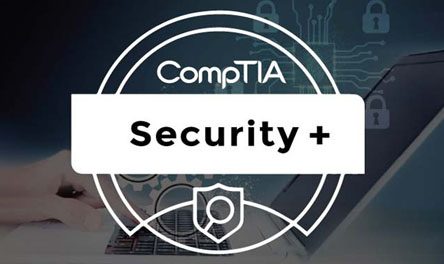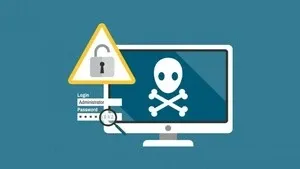This plan includes
- Limited free courses access
- Play & Pause Course Videos
- Video Recorded Lectures
- Learn on Mobile/PC/Tablet
- Quizzes and Real Projects
- Lifetime Course Certificate
- Email & Chat Support
What you'll learn?
- Understanding foundational cybersecurity concepts.
- Identifying various types of security threats and attacks.
- Implementing cryptography techniques for data protection.
- Developing skills in risk management and incident response.
- Securing network infrastructure and protocols.
Course Overview
Pre-requisites
- No specific prerequisites are required for the CompTIA Security+ course. Beginners are welcome. Basic computer skills recommended. Its better you have completed CompTIA A+ and N+ course.
Target Audience
- The CompTIA Security+ course is designed for individuals aspiring to pursue careers in cybersecurity. It's suitable for: Entry-level IT professionals seeking to specialize in security. Students or recent graduates interested in cybersecurity roles. IT professionals looking to validate their security knowledge and skills. Anyone aiming to enhance their understanding of cybersecurity fundamentals. Individuals preparing for security-related certifications or roles.
Curriculum 169 Lectures 16:59:04
Section 1 : Lesson 1 Summarize Fundamental Security Concepts
- Lecture 2 :
- Cyber Security Framework
- Lecture 3 :
- Gap Analysis and Access Control
- Lecture 4 :
- Security Control Categories
- Lecture 5 :
- Security Control Functional Types
- Lecture 6 :
- Information's Rolls and Responsibility and Units
Section 2 : Lesson 2 Compare Threat Types
- Lecture 1 :
- Introduction: Compare Threat Types
- Lecture 2 :
- Vulnerability, Threat, and Risk
- Lecture 3 :
- Attributes and Motivations of Threat Actors
- Lecture 4 :
- Different types of Threat actors and hacktivist
- Lecture 5 :
- Attack Surface and Vulnerable Software Vectors
- Lecture 6 :
- Network and Lure based attack
- Lecture 7 :
- Supply Chain Attack Surface
- Lecture 8 :
- Social Engineering - Impersonation and Pretextin
- Lecture 9 :
- Phishing, pharming and Typo squatting
- Lecture 10 :
- Compromise business Emails
Section 3 : Lesson 3 Explain Cryptographic Solutions
- Lecture 1 :
- Introduction of Cryptographic Solutions
- Lecture 2 :
- Cryptographic Concepts
- Lecture 3 :
- Symmetric Encryption
- Lecture 4 :
- Key Length
- Lecture 5 :
- Asymmetric Encryption
- Lecture 6 :
- Hashing
- Lecture 7 :
- Digital Signature
- Lecture 8 :
- Certificate Authorities
- Lecture 9 :
- Digital Certificate and Root of Trust
- Lecture 10 :
- Certificate Signing Requests and CN
- Lecture 11 :
- Certificate Revocation and Key Management
- Lecture 12 :
- Crypto processors and Secure Enclaves
- Lecture 13 :
- Key Escrow
- Lecture 14 :
- Encryption Supporting Confidentiality file, disk and database encryption
- Lecture 15 :
- Transport Encryption and Key exchange
- Lecture 16 :
- Perfect Forward Secrecy
- Lecture 17 :
- Salting, key stretching and Block Chain
Section 4 : Lesson 4 Implement Identity and Access Management
- Lecture 1 :
- Authentication Design
- Lecture 2 :
- Password concepts and password manager
- Lecture 3 :
- Multifactor and Biometric Authentication
- Lecture 4 :
- Type of Authentication Hard, soft and password less
- Lecture 5 :
- DAC and MAC
- Lecture 6 :
- Role-based and Attribute-Based Access Control
- Lecture 7 :
- Rule-Based Access Control
- Lecture 8 :
- Least privilege an user account provisioning
- Lecture 9 :
- Account Attributes and Access and restriction policies
- Lecture 10 :
- Local, Network, and Remote Authentication
- Lecture 11 :
- Directory Service and Single Sign-on Authentication
- Lecture 12 :
- Federation or Shared sign-on authentication
- Lecture 13 :
- SAML and OAuth
Section 5 : Lesson 5 Secure Enterprise Network Architecture
- Lecture 1 :
- Introduction: Maintain Enterprise Campus Network Architecture
- Lecture 2 :
- Architecture and Infrastructure concept
- Lecture 3 :
- Network Infrastructure
- Lecture 4 :
- Switching and Routing Infrastructure Considerations
- Lecture 5 :
- Security Zones and Attack Surface
- Lecture 6 :
- Port Security and Physical Isolation
- Lecture 7 :
- Architecture Considerations
- Lecture 8 :
- Device Placements and Attributes
- Lecture 9 :
- Layer 4 and Layer 7 Firewall
- Lecture 10 :
- Proxy Server and IDS
- Lecture 11 :
- NGF, UTM and Load Balancer
- Lecture 12 :
- VPN Remote Access Architecture
- Lecture 13 :
- IPSec and TLS Tunneling
- Lecture 14 :
- Internet Key Exchange in VPN
- Lecture 15 :
- RDP and Secure Shell
- Lecture 16 :
- Out of band Management and Jump Servers
Section 6 : Lesson 6 Secure Cloud Network Architecture
- Lecture 1 :
- Cloud deployment Models based on Ownership
- Lecture 2 :
- Security Considerations on Cloud Infra
- Lecture 3 :
- 6a-3 Types of Coluds based on services
- Lecture 4 :
- Responsibility Matrix Cloud Service Provider and Costumer
- Lecture 5 :
- Centralized and decentralized de-computing
- Lecture 6 :
- Resilient Architecture Concepts
- Lecture 7 :
- Virtualization and Cloud Technology
- Lecture 8 :
- Software Defined Networking
- Lecture 9 :
- Cloud Features and Security Consideration
- Lecture 10 :
- Embedded System and Industrial Control Systems
- Lecture 11 :
- Introduction of IOT Devices and its security
- Lecture 12 :
- Deperimeterization and Zero Trust
- Lecture 13 :
- Essential Components of a Zero Trust Architecture and Security
Section 7 : Lesson 7 Explain Resiliency and Site Security Concepts
- Lecture 1 :
- Introduction
- Lecture 2 :
- Asset Tracking and monitoring
- Lecture 3 :
- Asset Protection Concept
- Lecture 4 :
- Data Backups
- Lecture 5 :
- Advanced Data Protection
- Lecture 6 :
- Secure Data Destruction
- Lecture 7 :
- Continuity of Operations
- Lecture 8 :
- Capacity Planning Risks
- Lecture 9 :
- High Availability
- Lecture 10 :
- Testing Redundancy and High Availability and Clustering
- Lecture 11 :
- Diversity and Defense in Depth
- Lecture 12 :
- Deception technology and Testing Resiliency
- Lecture 13 :
- Physical Security
Section 8 : Lesson 8 Explain Vulnerability Management
- Lecture 1 :
- Introduction
- Lecture 2 :
- Operating System Vulnerabilities
- Lecture 3 :
- Vulnerability Types
- Lecture 4 :
- Zero-Day Vulnerabilities
- Lecture 5 :
- Misconfiguration Vulnerabilities
- Lecture 6 :
- Cryptographic Vulnerabilities
- Lecture 7 :
- Sideloading, Rooting, and Jailbreaking
- Lecture 8 :
- Application Vulnerabilities
- Lecture 9 :
- Evaluation Scope
- Lecture 10 :
- Common Web Application Attacks
- Lecture 11 :
- Cloud-based Application Attacks
- Lecture 12 :
- Supply Chain Vulnerabilities
Section 9 : Lesson 9 Evaluate Network Security Capabilities
- Lecture 1 :
- Benchmarks and Secure Configuration Guides
- Lecture 2 :
- Switches and Routers Security baseline
- Lecture 3 :
- Server Hardware and Operating Systems
- Lecture 4 :
- Wireless Network Installation Considerations
- Lecture 5 :
- Access Control Lists
- Lecture 6 :
- Intrusion Detection and Prevention Systems
- Lecture 7 :
- Web Filtering
Section 10 : Lesson 10 Assess Endpoint Security Capabilities
- Lecture 1 :
- Introduction of End point Security
- Lecture 2 :
- Endpoint Security and Protection
- Lecture 3 :
- Advanced Endpoint Protection
- Lecture 4 :
- Endpoint Configuration for enhancing Security
- Lecture 5 :
- Hardening End and Specialized Devices
- Lecture 6 :
- Mobile Hardening Techniques
- Lecture 7 :
- Full Device Encryption and External Media
- Lecture 8 :
- Different location Services in Mobile device
- Lecture 9 :
- Different Connection Methods in Mobile Device
Section 11 : Lesson 11 Enhance Application Security Capabilities
- Lecture 1 :
- Understanding of Secure Protocols
- Lecture 2 :
- Transport Layer Security
- Lecture 3 :
- Secure Directory Services
- Lecture 4 :
- Simple Network Management Protocol Security
- Lecture 5 :
- File Transfer Services
- Lecture 6 :
- Email Services
- Lecture 7 :
- Email Security
- Lecture 8 :
- Email Data lose prevention
- Lecture 9 :
- DNS Security
Section 12 : Lesson 12 Explain Incident Response and Monitoring Concepts
- Lecture 1 :
- Digital forensics Due Process and Legal Hold
- Lecture 2 :
- Data Acquisition from System Memory and Hard disk
- Lecture 3 :
- Preservation and Reporting in Digital Forensics
- Lecture 4 :
- Data Sources, Dashboards, and Reports
- Lecture 5 :
- Log Data
- Lecture 6 :
- Host Operating System Logs
- Lecture 7 :
- Application, Endpoint, and Network Data sources
- Lecture 8 :
- Packet Capture and Metadata
- Lecture 9 :
- Security Information And Event Management
- Lecture 10 :
- Alerting and Monitoring Activities
- Lecture 11 :
- Alert tuning and Monitoring Infrastructure
- Lecture 12 :
- Monitoring System and Applications and Benchmark
Section 13 : Lesson 13 Analyze Indicators of Malicious Activity
- Lecture 1 :
- Malware Classification
- Lecture 2 :
- Computer Viruses
- Lecture 3 :
- Computer Worms and Fileless Malware
- Lecture 4 :
- Spyware Adware and keyloggers
- Lecture 5 :
- Backdoors, RAT and rootkits
- Lecture 6 :
- Ransomware, Crypto-malware, and Logic Bombs
- Lecture 7 :
- TTPs and Malicious Activity Indicators
- Lecture 8 :
- Physical and Network Attacks
- Lecture 9 :
- Distributed Denial of Service Attacks
- Lecture 10 :
- On Path and DNS attack
- Lecture 11 :
- Wireless Attacks
- Lecture 12 :
- Password Credential Replay Attacks
- Lecture 13 :
- Cryptographic Attacks and Malicious Code indicators
- Lecture 14 :
- Application Attacks
- Lecture 15 :
- Replay and Forgery Attacks
- Lecture 16 :
- Directory Traversal Script and Command Injection Attacks
- Lecture 17 :
- Url and Log Analysis
Section 14 : Lesson 14 Summarize Security Governance Concepts
- Lecture 1 :
- Policies and Guidelines
- Lecture 2 :
- Procedures, playbook and Change management
- Lecture 3 :
- Internal and Industry Standards
- Lecture 4 :
- Legal Environment, governance and accountability
- Lecture 5 :
- Change management programs
- Lecture 6 :
- Restart, downtime, documentation and version Control
- Lecture 7 :
- Automation and orchestration
Section 15 : Lesson 15 Explain Risk Management Processes
- Lecture 1 :
- Risk Identification and Assessment
- Lecture 2 :
- Risk management Strategies
- Lecture 3 :
- Risk management processes
- Lecture 4 :
- Business Impact analysis
- Lecture 5 :
- Vendor Selection
- Lecture 6 :
- Legal Agreements
- Lecture 7 :
- Attestation and Assessments
- Lecture 8 :
- Penetration Testing and Security Exercise Types in an Organization
Our learners work at
Frequently Asked Questions
How do i access the course after purchase?
It's simple. When you sign up, you'll immediately have unlimited viewing of thousands of expert courses, paths to guide your learning, tools to measure your skills and hands-on resources like exercise files. There’s no limit on what you can learn and you can cancel at any time.Are these video based online self-learning courses?
Yes. All of the courses comes with online video based lectures created by certified instructors. Instructors have crafted these courses with a blend of high quality interactive videos, lectures, quizzes & real world projects to give you an indepth knowledge about the topic.Can i play & pause the course as per my convenience?
Yes absolutely & thats one of the advantage of self-paced courses. You can anytime pause or resume the course & come back & forth from one lecture to another lecture, play the videos mulitple times & so on.How do i contact the instructor for any doubts or questions?
Most of these courses have general questions & answers already covered within the course lectures. However, if you need any further help from the instructor, you can use the inbuilt Chat with Instructor option to send a message to an instructor & they will reply you within 24 hours. You can ask as many questions as you want.Do i need a pc to access the course or can i do it on mobile & tablet as well?
Brilliant question? Isn't it? You can access the courses on any device like PC, Mobile, Tablet & even on a smart tv. For mobile & a tablet you can download the Learnfly android or an iOS app. If mobile app is not available in your country, you can access the course directly by visting our website, its fully mobile friendly.Do i get any certificate for the courses?
Yes. Once you complete any course on our platform along with provided assessments by the instructor, you will be eligble to get certificate of course completion.
For how long can i access my course on the platform?
You require an active subscription to access courses on our platform. If your subscription is active, you can access any course on our platform with no restrictions.Is there any free trial?
Currently, we do not offer any free trial.Can i cancel anytime?
Yes, you can cancel your subscription at any time. Your subscription will auto-renew until you cancel, but why would you want to?
Instructor

9292 Course Views
8 Courses



 Tech & IT
Tech & IT
 Business
Business
 Coding & Developer
Coding & Developer
 Finance & Accounting
Finance & Accounting
 Academics
Academics
 Office Applications
Office Applications
 Art & Design
Art & Design
 Marketing
Marketing
 Health & Wellness
Health & Wellness
 Sounds & Music
Sounds & Music
 Lifestyle
Lifestyle
 Photography
Photography
























